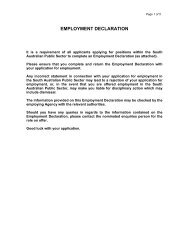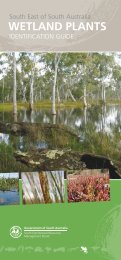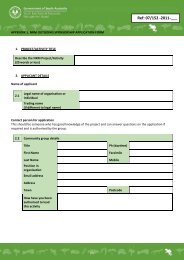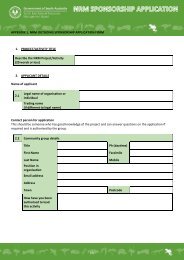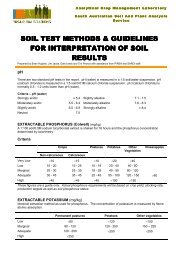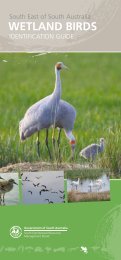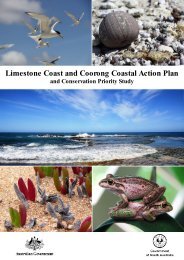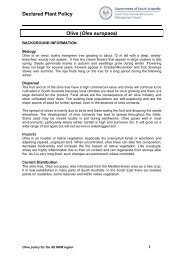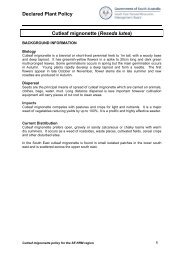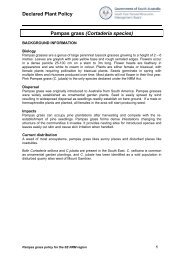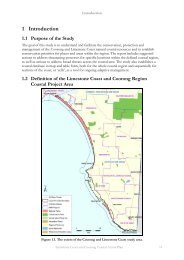Cell Descriptions - South East Natural Resources Management Board
Cell Descriptions - South East Natural Resources Management Board
Cell Descriptions - South East Natural Resources Management Board
Create successful ePaper yourself
Turn your PDF publications into a flip-book with our unique Google optimized e-Paper software.
SE6 – Lake Bonney SE<br />
the area only mention small sections of bare sand, i.e. accounts by Goyder and the Henty<br />
brothers in 1864 and 1830. However Goyder records the dunes here and in SE7 were grazed by<br />
sheep, cattle and horses. The management of Lake Bonney and surrounds was discussed in Lands<br />
SA, 1991, s.2.<br />
Cullen & Bird, 1980, p.B1, report here (and further north in the park) that many dunes were destabilised<br />
by 19C grazing and burning, and re-vegetation seen as contingent on rabbit and ORV<br />
control.<br />
Opportunities<br />
This project may provide the opportunity to review the management of the impact of ORVs<br />
within the park.<br />
Lake Bonney is described as the largest freshwater lake in <strong>South</strong> Australia (Lands SA, 1991). It<br />
receives one of the highest ratings for biological value and wetland attributes by Slater and<br />
Farrington (2010). Historically the lake would have been brackish (Haynes et al. 2007) however<br />
water supply is now supplemented by several drains. Along with an overall freshening of the<br />
system, these inputs have also attributed to an overall decline in the water quality of the lake.<br />
The main contributing factor is wastewater from pulp and paper mills. The lake had its natural<br />
outlet to the sea at the southern end however artificial cuttings were made through the dunes in<br />
1958 and 1972 (SEWC, 1984). The lake level is now controlled by a regulator on an artificial<br />
outlet. The main recommendations regarding Lake Bonney involve activities which will bring<br />
about an improvement in the water quality of the lake. Scientific monitoring has become a focus<br />
in the management of Lake Bonney. The EPA has collected information that suggests the quality<br />
of the lake is improving, however the EPA also recognises that following 60 years of pollution, it<br />
will take a long time to revert back to a healthy system (EPA, 2006). The use of wetland<br />
vegetation to filter inflows is currently being investigated by DENR (Slater and Farrington 2010).<br />
Conservation Analysis (GIS)<br />
The sum of conservation means gives this cell a low priority value (103.9), a result of extensive<br />
areas of low values in the de-vegetated dunes and the Lake Bonney water body reducing the total<br />
means for the cell. (The only high value layer for Lake Bonney was SE Wetlands, based on the<br />
SAWID assessment). However, parts of the Admella Dunes and the dunes bordering the<br />
northern end of Lake Bonney show very high total priority values due to endemic vegetation<br />
values and numbers of threatened plant species, numbers of plant species, habitat for reptiles and<br />
butterflies. This latter area includes small wetlands, which have high values as habitat for reptiles,<br />
including focal species Swamp Skink and <strong>South</strong>ern Bell Frog. The entire foreshore,



